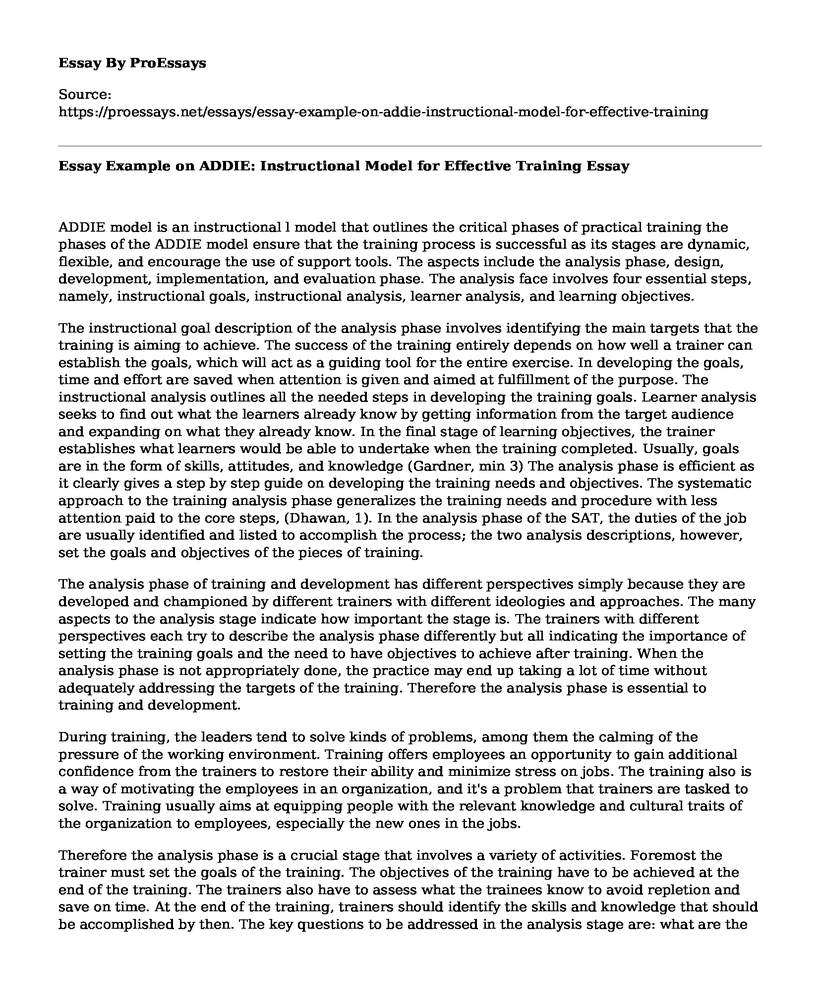ADDIE model is an instructional l model that outlines the critical phases of practical training the phases of the ADDIE model ensure that the training process is successful as its stages are dynamic, flexible, and encourage the use of support tools. The aspects include the analysis phase, design, development, implementation, and evaluation phase. The analysis face involves four essential steps, namely, instructional goals, instructional analysis, learner analysis, and learning objectives.
The instructional goal description of the analysis phase involves identifying the main targets that the training is aiming to achieve. The success of the training entirely depends on how well a trainer can establish the goals, which will act as a guiding tool for the entire exercise. In developing the goals, time and effort are saved when attention is given and aimed at fulfillment of the purpose. The instructional analysis outlines all the needed steps in developing the training goals. Learner analysis seeks to find out what the learners already know by getting information from the target audience and expanding on what they already know. In the final stage of learning objectives, the trainer establishes what learners would be able to undertake when the training completed. Usually, goals are in the form of skills, attitudes, and knowledge (Gardner, min 3) The analysis phase is efficient as it clearly gives a step by step guide on developing the training needs and objectives. The systematic approach to the training analysis phase generalizes the training needs and procedure with less attention paid to the core steps, (Dhawan, 1). In the analysis phase of the SAT, the duties of the job are usually identified and listed to accomplish the process; the two analysis descriptions, however, set the goals and objectives of the pieces of training.
The analysis phase of training and development has different perspectives simply because they are developed and championed by different trainers with different ideologies and approaches. The many aspects to the analysis stage indicate how important the stage is. The trainers with different perspectives each try to describe the analysis phase differently but all indicating the importance of setting the training goals and the need to have objectives to achieve after training. When the analysis phase is not appropriately done, the practice may end up taking a lot of time without adequately addressing the targets of the training. Therefore the analysis phase is essential to training and development.
During training, the leaders tend to solve kinds of problems, among them the calming of the pressure of the working environment. Training offers employees an opportunity to gain additional confidence from the trainers to restore their ability and minimize stress on jobs. The training also is a way of motivating the employees in an organization, and it's a problem that trainers are tasked to solve. Training usually aims at equipping people with the relevant knowledge and cultural traits of the organization to employees, especially the new ones in the jobs.
Therefore the analysis phase is a crucial stage that involves a variety of activities. Foremost the trainer must set the goals of the training. The objectives of the training have to be achieved at the end of the training. The trainers also have to assess what the trainees know to avoid repletion and save on time. At the end of the training, trainers should identify the skills and knowledge that should be accomplished by then. The key questions to be addressed in the analysis stage are: what are the training goals? Are the goals in line with the organizations' goals and needs? What skills do the trainees currently possess? What knowledge gap exists in the trainees to be compensated by the training? What are the objectives of the training?
Works Cited
Dhawan, Shiv, (2010) "The systematic approach to training: main phases of the training cycle."
Gardner Clark J. The ADDIE Analysis Phase. https://www.youtube.com/watch?v=JZdv5lrJs4U. Accessed on 20th March 20, 2020
Cite this page
Essay Example on ADDIE: Instructional Model for Effective Training. (2023, Apr 24). Retrieved from https://proessays.net/essays/essay-example-on-addie-instructional-model-for-effective-training
If you are the original author of this essay and no longer wish to have it published on the ProEssays website, please click below to request its removal:
- Experience From Your Life That Changed the Way You Think Essay
- Global Trends in Human Resource Management Essay
- Top 5 Career Opportunities in Media Industry - Essay Sample
- Movie Analysis Essay on Legally Blonde
- Social Inequality & Conflict Theory: Understanding Inequality in Society - Essay Sample
- Essay Sample on Education System: Outdated and Unjustified?
- Recruiting and Selecting Qualified Candidates: Best Practices in the Digital Era







